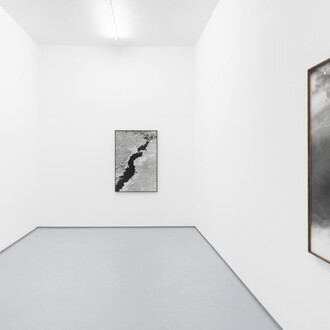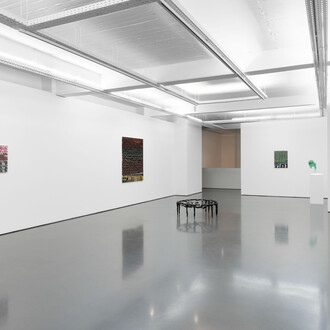A house is a privileged stage for the construction of identities, a space inhabited physically, but also a space brimming with memories – therefore becoming a place of negotiation between present and past, reality and imagination.
Despite its rigid setting, a house is done and undone repeatedly. It is in fact a temporary, fragile structure, and is determined not only by matter but by the relationships that are established with it and within it.
The German word “Heimat”, refers to the house precisely as an inhabited physical space, but also to the feeling of belonging to a place – to a country, to a city, or to a community. Therefore, “Heimat” implies different spaces, but also articulates an idea of formation, or of process, that evokes heterogeneous temporalities.
Those possible meanings incorporated by the word “Heimat” are the starting point for the materialization of Daniela Krtsch’s exhibition.
In fact, from a constellation of paintings – that give us rarefied, incomplete and partial images -, many possible narratives unfold – equally unfinished, inconclusive, and always mediated by the viewer’s own subjectivity.
The movement of our eyes over these paintings, that present themselves as reoccurrences, fragments, or details, sets itself, in this manner, as an instrument of suture, and its attempt to re-establish a stable core of meaning, is invariably predestined to fail. Like memory, that act, not only one of recovery but also of production, reveals itself always as insufficient, flawed, when faced with a past time.
This lack of definition inscribes itself in the paintings’ own surfaces, that take on different scales, and whose texture is defined somewhere between sharpness and opacity, revealing lines that either highlight presences or mark absences, disappearances, moments left hanging.
In these cracks that imagination opens up in the mist of its relation with daily life, characters arise that are diverted to an “other” dimension, tendentiously oneiric and even surreal, this way creating a strangeness in reality that builds a tension between the familiar and the unknown.
And therefore, it is as part of this process of strangeness that we can distinguish a creature that emerges, with a light-coloured body, floating, with cat ears, evoking a childlike world, still active, capable of contaminating the experience of the present. Not by chance, it is precisely childhood that, as a structural formative period, signals the beginning of what will constitute itself as “Heimat”.
Basing itself in the experience of displacement, such are the narratives that built our experiences of belonging, and that dilute the lines that divide reality and fiction, that Daniela Krtsch wants to question with this exhibition.
Giulia Lamoni & Margarida Brito Alves November 2014
Translation: Susana Pomba



















